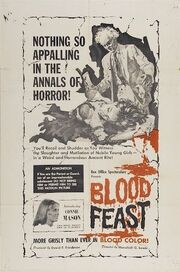
The 'first' Splatter film: Blood Feast in 1963
The Gore and Disturbing film is a genre of horror film, easily recognized by its use of extreme violence and disturbing and viceral imagery, even for a horror film. In fact, in this genre recreating blood and gore with special effects are seen as an artform itself. The genre is known for tackling taboos revolving around sex and cannibalism, using gore to shock as most as possible. It is not unusual for a Gore and Disturbing film to lack a true plot or a moral, the gore is more essential.[1] This genre can also be used as motive in different genres, like slashers or paranormal films.
Genres[]
The genre itself can be seperate further in four sub-genres:
- Torture films: Torture films, also referred to as Torture Porn due to sexual undertone in most torture flicks[2], are known for the extreme use of violence. The plot revolves around the physical pain and the emotional terror of prolonged torture.The goal of the experience is in most cases not to kill the victim, instead keeping him or her alive for as long as possible, while putting the victim through excrutiating pain. All for the viewing pleasure of the audience who rarely miss a part of the torture. The most famous Torture films is the SAW Franchise (2004-2010) and the Hostel Trilogy (2005-2011). The Torture genre is mostly combined with other genres as it is hard to make a stand-alone movie. The most used genres featuring torture porn are slashers, like Chain Letter (2010), Home Invasion, like The Collector (2009) but most dominant user of Torture Porn are Revenge Films: Last House on the Left (2009) and I Spit on Your Grave (2010).
- Splatter films (also known as Explotation films): Splatter film is the forefather of th entire Gore and Disturbing film genre. Established in the beginning of the 20th century, the Splatter film is known for making realistic gore into an art form.[3] So much that morals, characters and even plot were deemed less important. It was all about the imagery and shocking audiences with graphic mutilations. It seperates them from torture movies by the fact that they don't explicitly go for torture. The violence in most cases is meant to kill immediately but as bloody as possible. It will showcase the murder in a more graphic way that a regular slasher would. In modern times, the title of splatter films is given to every movie, horror or not, that accentuate excesses of violence. Acts of torture, cannibilism of sexual depravity are placed in the respectivly other genres.
- Cannibal films: Cannibal films are films based around the idea of the consumption of human flesh by other humans. The cannibal genre itself can be seperated in several sub categories: the most famous trope is the cannibalistic tribe trope, in which people discover a undiscovered tribe that thanks them by killing and eating them. This genre was very popular in the 80s. [4]. Other genres are the suburban cannibals, cannibals that life among us and survival cannibals. Examples of Suburban cannibals films is Masters of Horror's entry: The Washingtonians (2007) and the cannibal in Hostel: Part II (2007). An example of Survival cannibalism is Hunger (2009)
- Extreme films: Extreme films are those films that confront almost every taboo, with the sheer goal to shock audiences, most extreme movies don't even try to build tension, they just try to make the viewing experience as unpleasant as possible. An extreme movie can easily be recognized due to being overly sexualized, but the most acts of sex in these movies are what we would deem depraved: necrophilia, pedophilia, incest, excessive and brutal rape... Where Torture and Splatter films concentrate on mutilation of the overall body, the extreme movie concentrate more on genital mutilation or goes far further in the mutilation that any before mentioned genre. It is not unlikely to see defecating or urination in the torture as well as forced sodomy. In Extreme films, the humilation of the victim is central. We really see how you can break a human in the most brutal way. The genre originated from the banned story: 120 days of Sodom which was adapted many times in movie. In recent years, Tom Six contributed greatly to this genre with his Human Centipede Trilogy (2010-2015) and the media was shocked by the vile A Serbian Film in 2010..
History[]
The origins of Gore and Disturbing film comes from the darkest primal fears of people. Extreme pain. In most cases this is combinated with the fear of the decline of morals.
The Origin of Torture films[]
Torture has always scared people, as the tales of the Spanish Inquision still shocks people to this day. But the Torture genre like we know it today, spread from the Revenge genre: Someone get hurt (if female raped) but survives. He/She takes revenge in bloody fashion. One of the first was 1978's I Spit On Your Grave. During the golden age of horror, the Torture genre wasn't a prominent genre, as mostly Splatter films and Cannibal films were made. Many horror directors used torture scenes in their movie but featured it in such a way that the story didn't revolved around, excluding the typition of Torture films. It is so that the Torture films sprouted from the Splatter film. Where Splatter tries to portray violence as gruesome as brutal and vile as possible, Torture Films went further and created this excessive gore with Torture, prolonging the experience.
In the 2000s, the torture film genre became incredible popular as film makers were finally able to recreate horrendous torture scenes that look realistic. The name was first used to describe the movie Hostel (2005)[5]. Later movies like the Saw Series (2004-2010), Ichi the Killer (2001), Devil's Rejects (2005) and Baise-Moi (2000). The genre has proven to be very controversial, similar to the cannibal genre but also very profitable. The success of the SAW franchise, which has become the most profitable horror franchise ever, inspired directors all over the world to try the genre. This has led to some copycats like Captivity (2007), which can a similar setting as Saw II (2005). The genre was quickly used in combination with other horror genres like the Home Invasion genre, think of Gag (2006) and The Collector (2009), but also with non-horror genres as police thrillers, Untraceable (2008) for example. Mid 2000s, a new player joined the market as French directors tried their luck with the genres created the New French Extremity.[6][7] Products of this new wave were Frontières and À L'interieur (both 2007) and Martyrs in 2008. In 2009, the glory days of the Torture filmed seemed to be over already as Remakes took over the mantle of the most profitable genre for that moment.[8] The Torture films never fully recovered but this makes a good profit. Although, high-profile Torture Films are still made, the latest trend in this genre seems to be releasing direct to dvd, like Would You Rather and The Collection, sequel to the Collector (both 2012).
The genre hasn't only influenced the horror genre but also popular media in general, as it was featured in the song 3AM by American Rapper Eminem as well as leading to several publications about the genre and its socio-economic effects. One such publication is Steven Jones' Torture Porn, Popular Horror after Saw, published in 2013. [9]
The Origin of Splatter films[]
The origin of the Splatter film lies in the Grand Guignol theatre in France at the beginning the 20th century.[10] It was famous for it's realistic depictions of blood and carnage in the theatre and was in fact the precursor to Splatter Film. When coming to England, the gore was toned down in favor a more gothic atmosphere. [11] The first Splatter films dates back to 1916, making it the oldest film genre of the Gore family, (the cannibalism genre is overall older due to the use in horror literature.) and was named D. W. Griffith's Intolerance, showcases the slow impalement of a soldier. [12]
The genre relived after World War II, in the fifties and sixties, thanks to directors like Alfred Hitchcock with Psycho and Nobuo Nakagawa's Jigoku. (both 1960). Splatter films as a genre was created in the early sixties with the films of Herschell Gordon Lewis. He is one of the first to create scenes of visceral gore. The first film to be named Splatter films was Lewis' Blood Feast (1963) but was quickly followed by Two Thousand Maniacs! in the following year and Color me Blood Red the year after that (all having the same director). But as it grew in popularity, so did it grow in imfamy in both US and UK. 1978's I Spit on Your Grave led a charge in the UK to censor Splatter films for Home video. Near the end of 1980's most Splatter and Cannibal films were banned from the UK, as they were deemed to be Video Nasties. Nevertheless, the Splatter genre started the career of some of the most celebrated directors, one of them being Peter Jackson whose career started with Bad Taste (1987) and Braindead (1992). This lead to the creation of a new subgenre: Splatstick, visceral gore for comedic purposes. The genre has become quite popular in Japan, with movies as Machine Girl and Tokyo Gore Police (both 2008) and Robogeisha (2009).
Splatter films is still a dominant genre in the horror scene, leading to the creation of Torture Porn begin 2000s but also found use outside the horror genre. It has become incorporated in different genres like fantasy with Hansel and Gretel: Witch Hunters (2013), action flicks as the Machete series and as Grindhouse films like Hobo with a Shotgun (2011).
The Origin of Cannibal films[]
The oldest subgenre is cannibalism. Cannibalism finds it origin in the taboo of eating the flesh of another person, eiter to substain one's life or darker reasons. Cannibalism dates back to the stone age and was featured in many drifferent stories (Hansel and Gretel by the Brothers Grimm) and spawned other genres like the werewolf genre and the legend of the Wendigo. In literature, Cannibalism was mostly tributed to tribal people who lived in vast forests. An example of this is a novel written in 19th century, Typee by Herman Melville. A few stories portray survival cannibalism, how far are you willing to survive. The Cannibal genre got his biggest and most notorious boom however between 1970 and 1990, peaking from 1977 to 1981 (this peak became known as the Cannibal Boom). In the hayday, Italian horror directors breathed new life in the Cannibal genre, mostly depicted savage movies of a cannibalistic tribes in the rainforest. This also have birth to the Found-Footage genre. This period brought forth movies like Cannibal Ferox (1981), Antropophagus (1980) and of course, the one of the most notorious movies ever, Cannibal Holocaust (1980). The Cannibal genre and namely Cannibal Holocaust have created the Found Footage Trope as it was one of the first to use it. A few American directors jumped on the banwagon like Wes Craven's The Hills Have Eyes (1977), a movie based on the story of Alexander Bean. Craven's work broke with the tradition of the Italians as he depicted a clan of mutated cannibals in Nevada, rather than tribal cannibals.The fluorishing of the Cannibal genre, had great impact on the movie industry but due to extreme graphic nature of the films, most ended up the Video Nasties list and were banned in several countries.
Even though the big hype ended around 1988 with Natura Contro, the genre was never abandon. Cannibalism plays an important role in movies like the Wrong Turn Series (2003-) and is featured in many other horror movies as to increase shock value: movies like Hostel: Part II (2007) and The Woman (2010).
The Origin of Extreme films[]
One of the earliest works of extreme literature are the writings of Marquis de Sade, an his blasphemous novel 120 Days of Sodom in 1785. The novel is infamous for his extreme pornographic nature as well as its depraved content. The novel was so controversial, the book was banned. The genre never rolled high eyes as during the Golden Age of Horror in the 70s and 80s,most of the Gore and Disturbing movies were Cannibal films or Splatter Films. One of the most notorious Extreme films made in this Golden Age is the Guinea Pig series (1985-1988), with explored the darkest regions of the human mind. Although borrowing elements from the Torture genre, it could best be described as extreme as the first chapter was long time believed to be one of the first real snuff movies (This was later proven to be false). Another infamous movie of the genre is the German movie Necromantik , exploring the ideas of necrophilia.
But in beginning of the new millenium, the Extreme films have got a revival with movies as Visitor Q (2001). But the real revival came as movies like Saw and Hostel revived the Torture genre, movie makers started to explore how far they could go. This resulted in movies like Grotesque (2009) and Meat Grinder (2009). A few movies even span series like The Human Centipede Trilogy. Some film makers used the notority to make a gruesome statement, the perfect example is the depraved picture: A Serbian Film (2010).
Critical analysis[]
The genre is a mostly a niche genre with the expections like SAW which gained popularity over the years. From the beginning, of the French Grand Guignol which was censored when it went to England, to the splatter films that lead to the creation of the video nasties list that would be later filled with cannibal films, the Gore and disturbing genre is the easily the most controversial genre of the horror industry. Even today, movies like Hostel and A Serbian Film are censored or if censorship won't work, outright banned. Most critics complain about the use of extreme violence in favor of telling a story and the movies are often repoarched of misogny and sadism as well as shunned for the overuse of nudity. It was critic David Edelstein who invented the term Torture Porn to name the Torture genre. But although most are gore and disturbing films are shunned by most critics and the mainstream media, some still manage to shine and gain praise: an example of this the critically acliamed extreme film: Antichrist, directed by Lars Von Trier.
Notable films[]
Torture films[]
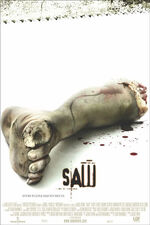
Saw (2004) - Two men, Lawrence and Adam, find themselves chained in a bathroom with the corpse of a third man in the middle of the bathroom. The only thing they have, is a gun used by the dead man to take his own life, and a taperecorder. When the tape is played, they quickly learn that they are trapped in this bathroom by a man known as the Jigsaw Killer. The killer gives Lawrence 7 hours to kill Adam or his family will die. Ironically, Lawrence was once suspected to be the Jigsaw Killer, who already had killed 3 persons (in later films revealed to be 5) as a third victim managed to survive his deadly game. Saw spawned 6 sequels, released around Halloween each year. It is known as the most succesful horror series ever.
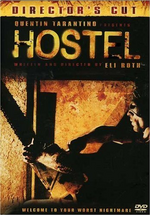
Hostel (2005) - Three horny young men visit Amsterdam for the whores and the pot. They quickly met up with a man named Alex, who tells about a place in Eastern Europe were women are willing to have sex with men for free, as the war have ravaged the country. Not caring which war this would be, they travel to Slovakia, and seems to have the vacation of their life. But the country doesn't seem to be what Alex said it would be. In fact, the women were a trick and the three men are selled to the Elite Hunting Club , an organization that offers its member the change to get away with torture and eventually murder. Hostel got a sequel in Hostel Part II 2007 and eventually a third chapter was released direct-to-dvd in Hostel Part 3 2011, taking the action from Slovakia to Las Vegas.
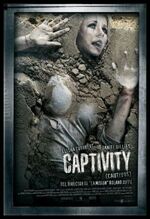
Captivity (2007) - A young model finds herself trapped in a house of horror. Her captorsr shows her images of his earlier work and if she do nothing, she will under go the same fate. After a while she discovers she isn't the only one trapped in the house. A young man, Gary tries to help her getting out but with no idea how to get out or who is behind this all, that isn't an easy task.
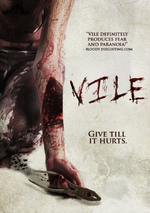
Vile (2011) - A group of people walks up in an abandon house with a strange contraption around their head. The reason why they are here and what the device is meant to do, is explained shortly after by a message of elderly woman. The human body is capable of creating a very rare and valuable chemical, a chemical that is used in a very exclusive and expensive drug. But the only way that the human body is able of creating this chemical is when experienced extreme pain. They get 24 hours to collect the required amount. Failure will punished by death. Every item can be used to create pain...
Splatter films[]
Blood Feast (1963) - Suburban Miami is terrorized by a brutal murderer who butchered his female victims and take body parts with them. As the FBI tries to solve the case, the murderer continues his quest to recreate a dormant Egyptian goddess Isthar. To bring back to this mother of veiled darkness, a blood feast is required and our killer makes sure she will get just that. Blood Feast is viewed by many as the first Splatter film and was It.
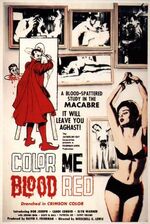
Color Me Blood Red (1965) - A deranged artist has a creative block until he discovers new inspiration as he tries a new paint. The blood of the innocent will be his paint and as he color the canvas, he leaves death in his wake. Everything for the sake of art... The movie was known as the final chapter of the Blood trilogy.
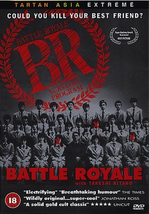
Battle Royale (2000) - As the people grow scared of the rebellious youth, of which some even attack their teachers and others, the Japanse goverment is forced to take drastic measures. In order to get control back over their country and silence any opossition in the process, they enacted the Millenium-Act, better known as Battle Royale. Each year, a class of high school children will be selected, kidnapped and dropped on an island with one simple instruction: Kill of each other in 3 days till there is one surviver or die all. Battle Royale is one of the most influencial movies ever made and was based on a roman with same name from 1997.
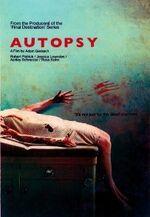
Autospy (2008) - A group of students get into a car accident in which they run over a man. Luckily for them, an ambulance arrives shortly after to take the man with them and offer the students to come with them for a check-up. They agree and go with the ambulance to the Mercy Hospital. But the hospital is strangely abandon, have almost no other patient. It is only later that they realize that the man they run over was actually fleeing from the bizarre and inhumane experiments of the owner and surgeon of the Mercy Hospital. Autospy is a part of the After Dark Films.
Cannibal films[]
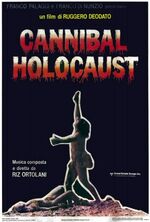
Cannibal Holocaust (1980) - After a film crew disappeared while shooting a documentary, a group of investigators is send to find the crew in the rainforest. They quickly finds a native tribe which isn't trusting of outsiders. The investigators quickly discovers that the film crew was slaughtered and cannibalized by the tribe. But eventually they can come to an agreement, a tape recorder for the film reel of the first crew. But after seeing the film, they finally realized why the tribe was not trusting them. The footage begs the question: who were the real savages, the cannibalistic tribe or the film crew? Cannibal Holocaust gained notority due to its gruesome portray of violence and it revolutianary special effects.
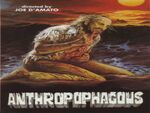
Antropophagus (1980) - A group of tourist strands on what appears to be an unhabitant island. But this wasn't always that way. As they find an abandon village. To their horror, they discover that someone killed the villagers and cannibalized a few of them. They find a young girl who tells about this madman who smells like blood. They quickly realized that coming to island was a terrible idea, as they are the next targets of this madman. The movie is infamous for its cannibalistic imagery and the devourment of a unborn human fetus.

2001 Maniacs (2005) - A group of different people finds themselves guests at a small southern town, Pleasant Valley, population 2001, holding an annual jubilee to honor the deaths of the American Civil War. Although the villagers are a bit odd, dressed in clothing of that time period, they enjoy the festivities. Unbeknownst to them, they are picked off one by one by the vengeful inhabitants of Pleasant Valley. This movie was a remake of Two Thousand Maniacs (1964), the second chapter in the blood trilogy.
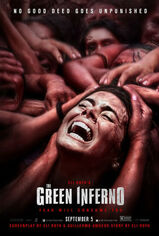
The Green Inferno (2013) - A group of student environment activits takes their action up a notch and travel from New York to the Amazon, to help safe the forest. But they didn't realize that even with people who have the best intentions, bad things can happen. Especially when dealing with cannibalistic tribes. This was Eli Roth's tribute to the cannibal genre of 80s, with most notable a homage to Cannibal Holocaust, one of Eli Roth's favorite movies and inspiritation to him.
Extreme films[]

Saló or 120 Days of Sodom (1975) - A story about the explotation and humiliation of 18 peoplen the film tells about the days after the fall of Mussolini. The tormentors are four powerful liberterians who with the help of some prostitues commit one depraved act after the other. Their perversity knows no bounds with a mercy non-existant. The movie is based on the novellete of Marquis de Sade, who was thrown in jail for his perverse writings and behavior, the word Sadism is even derived from his title.
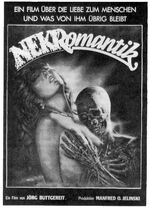
NEKRomantik (1987) - Rob Schmadtke is a cleaner of bodies. When an accident occurs he is the one who cleans up the mess. But for him, this is more than his job, it is a hobby and a sexual fantasy. One day, he takes a corpse to his home so he and his wife can enjoy a threesome with the corpse. The main theme of this west German movie is necrophillia, neglect, violence and suicide. All of this, explored in gruesome detail. It spawns even a sequel...
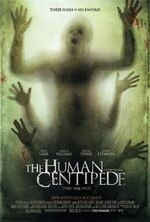
The Human Centipede (First Sequence)]] (2009) - Dr. Heitner is a celebrated surgeon with his speciality being the splitting Siamese twins. But the doctor has a few a problems: he is asocial, disliking the presence of other humans and has very dark fantasy. His lifelong dream is instead of splitting Siamese twins, putting together a human centipede with whoever is unlucky enough to cross his path. The movie gained controversy due to the main concept of the movie, sewing three people together ass-to-mouth. Nevertheless, the movie spawned a metasequel in 2011 with the Full Sequence and the trilogy is planned to in 2015 - 2016 in Final Sequence.
A Serbian Film (2010) - An ex-pornstar gets the change to star in a new project by a czech filmmaker. It is supposed to be an art film but it quickly begs the question: what can be defined as art? The director' twisted sense of film making forces the man to go into very dark places: ranging from snuff to rape to pedophilia, everything in the name of art. A Serbian film is one of the most controversial films of the new millenium by a combination of viceral scenery with shocking content: most notable the concept of Newborn Porn... According to the makers, it is a diary of the molestation of the Serbian people by the government. 'It's about the monolithic power of leaders who hypnotize you to do things you don't want to do. You have to feel the violence to know what it's about.'
References[]
- ↑ McCarty, John (1984). Splatter Movies: Breaking the Last Taboo of the Screen. New York City, New York: St. Martin's Press.
- ↑ Boucher, Geoff (3 June 2007). "A queasy-does-it guy". latimes.com. Retrieved 9 July 2012.
- ↑ Arnzen, Michael (1994). "Who's Laughing Now?...The Postmodern Splatter Film". Journal of Popular Film and Television.
- ↑ David Carter. "Savage Cinema". Savage Cinema. Retrieved 2006-09-06.
- ↑ Warner, Kara. "Saw IV Press Conference". UGO.com.
- ↑ Quandt, James (February 2004). "Flesh & Blood: Sex and violence in recent French cinema". Artforum. Retrieved 2008-06-10. Also available on the ArtForum website (requires registration).
- ↑ Palmer, Tim "Style and Sensation in the Contemporary French Cinema of the Body", Journal of Film and Video, Fall 2006 [4] Access date: 14 May 2010.
- ↑ Bowles, Scott (February 13, 2009), "Classic horror films come back to life, profitably". USA Today. Retrieved on June 4, 2009.
- ↑ Jones, Steve (2013) Torture Porn: Popular Horror after Saw (Basingstoke: Palgrave-Macmillan), pp.2-3, 18-22
- ↑ McCarty, John (1984). Splatter Movies: Breaking the Last Taboo of the Screen. New York City, New York: St. Martin's Press.
- ↑ McCarty, John (1984). Splatter Movies: Breaking the Last Taboo of the Screen. New York City, New York: St. Martin's Press.
- ↑ Tim Dirks. "Intolerance (1916)". The Best Films of All Time – A Primer of Cinematic History.
